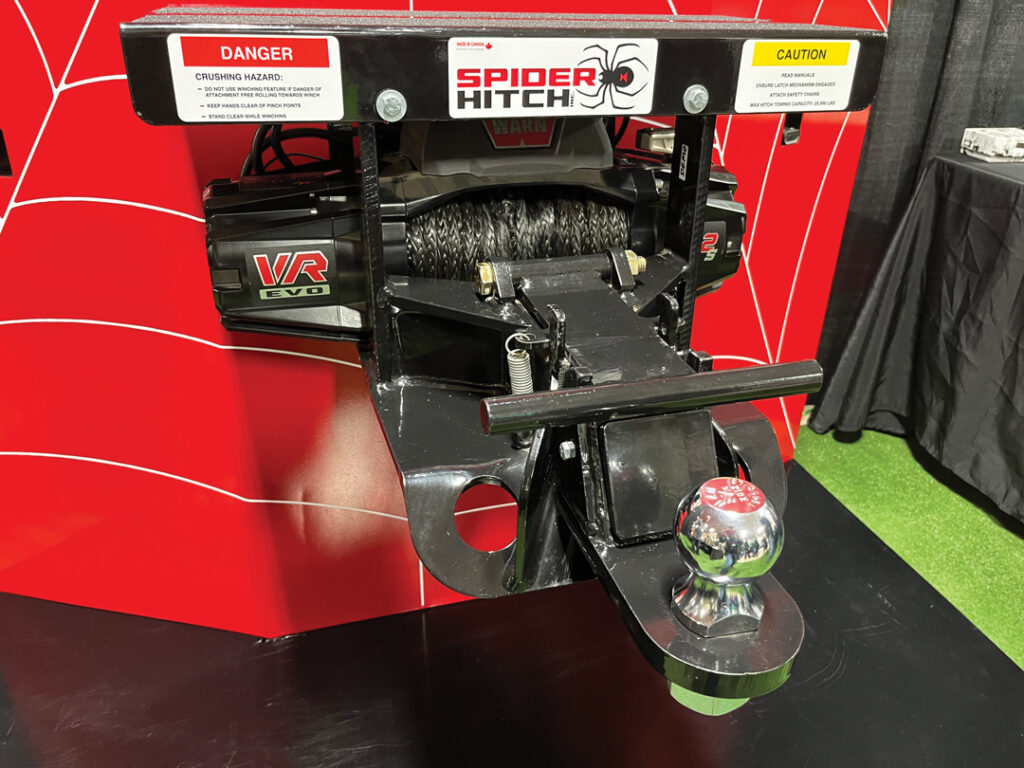ONE LITTLE HITCH
BY IAN DOIG • ILLUSTRATION BY EMILY CHU
Real Garant began his work life at 18 farming grain and forages with his father and two brothers in the Donnelly area. In winter, he took a job at a local sawmill operated by relatives. A general labourer, he was inquisitive and bombarded maintenance staff with questions. Over following seasons, he serviced air and electrical systems and began welding and machining various parts. To beef up his farm skillset, he took an apprentice machining course at NAIT. Soon after, he established a small shop on the farm. Customer demand grew quickly. He rented his land to his brothers and threw himself into the launch of his own full time business, Donnelly Machining and Fabricating. The business serves a wide variety of clients in agriculture and agri-food manufacturing, the heavy equipment and forestry industries and even schools and hospitals. It’s a go-to business in the Upper Peace Region, but it is Garant’s 2022 product the Spider Hitch, which launched a second enterprise that carries international potential.
GrainsWest: What sparked the idea for the Spider Hitch?
Real Garant: A local farmer requested we design something for him, and we partnered to start Spider Hitch. His farm acquired the first three John Deere X9 combines in the area, the biggest at the time. They love the combines, but hitching up was an issue. Crossing rivers and the highway they quite often had to trailer the large headers. He said, “Can we solve this problem?” He threw some ideas by me. I really like designing and engineering new ideas, so I went to my drafting and thinking room and pieced things together.
GW: Did your partner leave the business?
RG: He couldn’t do the business and continue to farm, so he sold out. I asked my son David, daughter Chantel Jodoin and wife Elaine to join the business. My son-in-law Daniel Jodoin is also a main worker. It’s been a huge learning curve. The first six months were crazy; sourcing materials, setting up, patenting and trademarking.
GW: How does Spider Hitch work?
RG: I built the first three in April 2021 for that John Deere model. They used the prototype that fall and really liked it. In the past, they had to have three people to hitch up. They would have the operator in the combine seat looking in his mirror. He’s watching for hand signals from someone beside the combine, and a third person would hold the hitch up under the combine.
That was a safety concern, especially at nighttime or if it was dusty. There were visibility and communication issues. Also, to hitch up, you take two guys away from what they’re doing. Our goal was to eliminate those issues.
It has a 12,000-pound Warn Industries winch and 80 feet of synthetic line instead of steel cable. If you tug on them hard, steel cables can coil up like a spring. Then they’re harder to work with; it doesn’t want to coil back and lie there nicely. If you get wire breakage, you get these little needles that spike into your fingers and can injure people. The synthetic line doesn’t have these issues.
The driver alone can position the combine approximately. Some people don’t even back up. They get out of the seat, disengage the latch and pull the hitch itself, the unit that is removable, away from the combine to where your header trailer is. They’ll lock the hitch in place, go back to the winch and re-engage the clutch. And then you just stand back with a wireless FOB that has a 300-foot range. You pull the trigger, and it pulls it back in, lines it up and auto latches. It typically takes about 45 seconds to hitch up. You can do it in the middle of the night.
GW: Do customers ask why someone hasn’t thought of this before?
RG: We heard a lot of that, especially the second year we did trade shows. “You’re a marriage saver,” and from retired farmers, “Where were you 40 years ago?”
GW: Does the prototype differ from the final product?
RG: The prototypes have been in use for a few years with no issues, but I wanted to create as much redundancy as possible. Two hooks in the latch, two springs and so on to double the safety.
We drilled a series of hole patterns to fit on as many combine makes as possible. That allowed us to supply a kit of bolt spacers and hardware needed to mount it to a lot of the New Holland combines. It will work on the latest New Holland CR11 and Case IH combines, including the AF11. All the S Series and X Series John Deere combines. Some dealerships sell the X9 with the Spider Hitch on it.
GW: In 2023, you posted a Facebook video of the Spider Hitch hitching a combine header, and it went viral.
RG: By the fifth day, we had 13.5 million views. We then got inquiries from everywhere: Australia, Europe, India, Mexico, New Zealand, Scandinavia, South America. Now that video is at almost 41 million views.
GW: Was that when you first realized you had a hit on your hands?
RG: Yes. At the beginning, we wanted to make sure it was patented and the intellectual property was protected before we really put it out there. Once that was safe, we did a little batch, then a bigger batch and so on. We approached a company just north of Calgary to manufacture the components and ship them north to us. We do all the assembly, testing, the literature and hardware package and the crating and shipping.

GW: Can you keep up with demand?
RG: We’ve ramped up. At the beginning, we worked like slaves, but now it’s better. In our machine shop we built a long, specialized work counter with the necessary stations and equipment needed to assemble things easily and quickly. It’s like a miniature assembly plant.
GW: Where is Spider Hitch sold?
RG: Primarily in Canada and the United States.
GW: Will you export beyond the two countries?
RG: Definitely. We’ve had serious inquiries and talks with people in Australia, Europe and Mexico.
GW: Can Spider Hitch be used for additional farm tasks?
RG: We did an update, so it is highway approved. It can be used behind a service truck. Some farmers are putting it on their toolbar, pulling in the anhydrous tank. The majority is combine headers, but second would be anhydrous application or delivery.
GW: Can it be used outside of agriculture?
RG: We’ve had inquiries from forestry, mining and heavy construction.
GW: Spider Hitch won the grand prize of $20,000 at the Ag Innovations Awards competition at the Agri-Trade Equipment Expo in Red Deer in 2023. What was that like?
RG: It was thrilling to receive the top prize and all that entails: the whirlwind of publicity from newspapers, magazines, television and radio. It opened doors.
GW: What advice would you give to other independent business owners who have developed new agricultural products?
RG: Make sure your intellectual property is protected. If it does take off, people will try to copy it. Don’t cheap out. Use proper engineering and testing. Do the homework so you can be confident in describing your product, how it works and how safe it is.







Comments